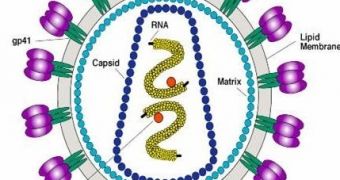The AIDS epidemic keeps on spreading around the world and the current number of those infected with HIV is now estimated at 39.5 million people worldwide, an increase with 2.3 million over the past 2 years, according to an annual report released by the Joint United Nations Programme on HIV/AIDS (UNAIDS).
In 2005, 2.9 million people died of AIDS. Researchers from UNAIDS and the World Health Organization (WHO) encountered encouraging and discouraging trends on the globe. "The evidence is showing that not only is the global epidemic growing, but there are also worrying trends where some countries are seeing a resurgence in infection rates," says Paul De Lay, who leads the report.
Countries that in the past saw a success in the fight against AIDS are now confronted with a resurgence of the epidemics, like in Thailand and Uganda. Homosexual men account for 21% of new infections in Thailand, but cases are also growing in heterosexual couples in some rural areas of Uganda. Both situations are correlated with the lack of condom use.
For the first time, HIV's spread through drug injecting syringes has been documented in countries in sub-Saharan Africa: Kenya, Tanzania, Nigeria, and South Africa. Sub-Saharan Africa accounts for 63% of all infections worldwide. In several parts of the world, married women were exposed to an increased risk.
In South Africa, the country with the largest number of HIV infections worldwide, "HIV infection levels among young pregnant women appear to be stabilizing, [but] they continue to increase among older women".
In Eastern Europe and Central Asia - regions with a relatively recent epidemic - the yearly number of new infections rose by 70% higher compared to 2 years ago, and the total increase in a decade was of 20 times.
Roughly 90% of the region's infections are found in the Russia and the Ukraine, with unprotected sex and drug injecting the main causes. "Solid scientific evidence has shown that strategies such as needle exchange can powerfully slow the spread," says epidemiologist Kevin De Cock, who heads the HIV/AIDS program for the WHO.
In Portugal, such programs led to a 31 % decrease in HIV cases in 2005 compared to 2000.
While HIV infection in the United States and western/central Europe keep on increasing, this may be largely due to the fact that better treatment prolongs AIDS patients' life rather than a considerable increase in new infections.
Some hits on the fight against AIDS have been though achieved. In some Sub-Saharan Africa, prevalence fell by at least 25% among 15- to 24-year-old pregnant women in cities in Kenya, C?te d'Ivoire, Malawi, and Zimbabwe. A decrease in HIV prevalence among young people between 2000 and 2005 was found in Botswana, Burundi, Ivory Coast, Kenya, Malawi, Rwanda, Tanzania, and Zimbabwe. In China, an increase in condom use by sex workers decreased the sexually transmitted infection. "The world is spending more money than ever before to combat AIDS," says De Cock. The researchers warn that in countries such as Burma/Myanmar and Zimbabwe, "political and human rights considerations limit both what we know about HIV and what a U.N. agency can say."

 14 DAY TRIAL //
14 DAY TRIAL //